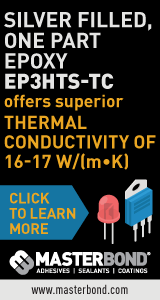|

|
Reliability of Copper, Gold, Silver and PCC Wirebonds Under Operation
Materials Tech |
|
Authored By:Pradeep Lall & Shantanu Deshpande Auburn University NSF-CAVE3 Electronics Research Center AL, USA Luu Nguyen Texas Instruments, Inc. CA, USA SummarySemiconductor packaging industry is transitioning to use of alternate lower cost wirebond materials to replace gold (Au) wire which is often used in high-reliability applications. Typical wire diameters vary between 0.8mil to 2mil. Recent increases in the gold-price have motivated the industry to search for alternate materials candidates for use in wirebonding. Three of the leading wirebonding candidates are Silver (Ag), Copper (Cu), and Palladium Coated Copper (PCC). The new material candidates are inexpensive in comparison with gold and may have better electrical, and thermal properties, which is advantageous for fine pitch-high density electronics. The transition, however, comes along with few trade-offs such as narrow process window, higher wire-hardness, increased propensity for chip-cratering, lack of reliability knowledge base of when deployed in harsh environment applications. Relationship between mechanical degradation of the wirebond and the change in electric response needs to be established for better understanding of the failure modes and their respective mechanisms. Understanding the physics of damage progression may provide insights into the process parameters for manufacture of more robust interconnects. In this paper, a detailed study of the electrical and mechanical degradation of wirebonds under high temperature exposure is presented. Four wirebond candidates (Au, Ag, Cu and PCC) bonded onto Aluminum (Al) pad were subjected to high temperature storage life until failure to study the degradation of the bond-wire interface. Same package architecture and electronic molding compound (EMC) were used for all four candidates. Detailed analysis of intermetallic (IMC) phase evolution is presented along with quantification of the phases and their evolution over time. Ball shear strength was measured after decapsulation. Measurements of shear strength, shear failure modes, and IMC composition have been correlated with the change in the electrical response. Change in shear strength and different shear failure modes for different wirebond systems are discussed in the paper. ConclusionsDegradation of different wirebond material candidates including Ag, Au, Cu and PCC subjected to high-temperature thermal aging was presented in this paper. Performance of Au wirebond was considered as benchmark and compared with Cu, PCC, and Ag wirebonds bonded onto the Al-pad. Experiments were performed on molded 32-pin QFN daisy chained packages. Change in resistance of the wirebonds was observed using resistance spectroscopy technique. Acid based decapping process was used to remove the EMC and perform ball shear tests. Experimental measurements indicate that Cu and PCC wires had different modes of shear failure than Au wirebonds. Cross sectioning was used to study the bond interface. Au-wirebonds, which failed first had high IMC growth rate among all candidates. Presence of large voids reduced shear strength of the wire at much faster rate. Even though Ag wirebond had rapid IMC growth than Cu and PCC, it proved to be more reliable. This was because of high conductivity of the Ag IMC’s and very slow crack propagation. Cu and PCC wires had very slow IMC growth rate. Upon failure, corrosion based microcracks and localized detachment was observed for both wires. Presence of Pd at the interface was found to lower the IMC growth and crack propagation rate, making it more reliable than Cu. Change in electric response of the wirebonds was then correlated with the IMC growth and cracking/voiding phenomenon. Changes in shear strength and shear failure modes were also correlated with the changes in the morphology of the bond-pad interface and increase in the resistance of the bond wires. Initially Published in the SMTA Proceedings |
|
Comments
|
|
|
|

|


